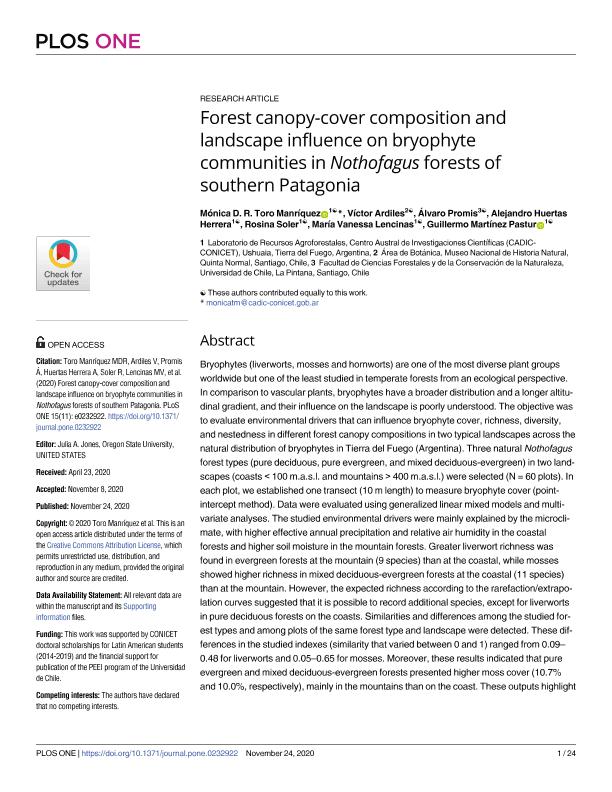Mostrar el registro sencillo del ítem
dc.contributor.author
Toro Manríquez, Mónica del Rosario

dc.contributor.author
Ardiles, Víctor
dc.contributor.author
Promis, Álvaro
dc.contributor.author
Huertas Herrera, Alejandro

dc.contributor.author
Soler Esteban, Rosina Matilde

dc.contributor.author
Lencinas, María Vanessa

dc.contributor.author
Martínez Pastur, Guillermo José

dc.date.available
2021-02-17T19:09:52Z
dc.date.issued
2020-11
dc.identifier.citation
Toro Manríquez, Mónica del Rosario; Ardiles, Víctor; Promis, Álvaro; Huertas Herrera, Alejandro; Soler Esteban, Rosina Matilde; et al.; Forest canopy-cover composition and landscape influence on bryophyte communities in Nothofagus forests of southern Patagonia; Public Library of Science; Plos One; 15; 11-2020; 1-24
dc.identifier.issn
1932-6203
dc.identifier.uri
http://hdl.handle.net/11336/125839
dc.description.abstract
Bryophytes (liverworts, mosses and hornworts) are one of the most diverse plant groups worldwide but one of the least studied in temperate forests from an ecological perspective. In comparison to vascular plants, bryophytes have a broader distribution and a longer altitudinal gradient, and their influence on the landscape is poorly understood. The objective was to evaluate environmental drivers that can influence bryophyte cover, richness, diversity, and nestedness in different forest canopy compositions in two typical landscapes across the natural distribution of bryophytes in Tierra del Fuego (Argentina). Three natural Nothofagus forest types (pure deciduous, pure evergreen, and mixed deciduous-evergreen) in two landscapes (coasts < 100 m.a.s.l. and mountains > 400 m.a.s.l.) were selected (N = 60 plots). In each plot, we established one transect (10 m length) to measure bryophyte cover (pointintercept method). Data were evaluated using generalized linear mixed models and multivariate analyses. The studied environmental drivers were mainly explained by the microclimate, with higher effective annual precipitation and relative air humidity in the coastal forests and higher soil moisture in the mountain forests. Greater liverwort richness was found in evergreen forests at the mountain (9 species) than at the coastal, while mosses showed higher richness in mixed deciduous-evergreen forests at the coastal (11 species) than at the mountain. However, the expected richness according to the rarefaction/extrapolation curves suggested that it is possible to record additional species, except for liverworts in pure deciduous forests on the coasts. Similarities and differences among the studied forest types and among plots of the same forest type and landscape were detected. These differences in the studied indexes (similarity that varied between 0 and 1) ranged from 0.09- 0.48 for liverworts and 0.05-0.65 for mosses. Moreover, these results indicated that pure evergreen and mixed deciduous-evergreen forests presented higher moss cover (10.7% and 10.0%, respectively), mainly in the mountains than on the coast. These outputs highlight the need to explore differences at greater altitudinal ranges to achieve sustainability objectives conservation planning for bryophytes in southernmost forests.
dc.format
application/pdf
dc.language.iso
eng
dc.publisher
Public Library of Science

dc.rights
info:eu-repo/semantics/openAccess
dc.rights.uri
https://creativecommons.org/licenses/by-nc-sa/2.5/ar/
dc.subject
Drivers
dc.subject
Mosses
dc.subject
Liverworts
dc.subject
Nothofagus
dc.subject.classification
Silvicultura

dc.subject.classification
Agricultura, Silvicultura y Pesca

dc.subject.classification
CIENCIAS AGRÍCOLAS

dc.title
Forest canopy-cover composition and landscape influence on bryophyte communities in Nothofagus forests of southern Patagonia
dc.type
info:eu-repo/semantics/article
dc.type
info:ar-repo/semantics/artículo
dc.type
info:eu-repo/semantics/publishedVersion
dc.date.updated
2020-12-04T14:43:09Z
dc.journal.volume
15
dc.journal.pagination
1-24
dc.journal.pais
Estados Unidos

dc.journal.ciudad
San Francisco
dc.description.fil
Fil: Toro Manríquez, Mónica del Rosario. Consejo Nacional de Investigaciones Científicas y Técnicas. Centro Austral de Investigaciones Científicas; Argentina
dc.description.fil
Fil: Ardiles, Víctor. Museo Nacional de Historia Natural de Santiago; Chile
dc.description.fil
Fil: Promis, Álvaro. Universidad de Chile; Chile
dc.description.fil
Fil: Huertas Herrera, Alejandro. Consejo Nacional de Investigaciones Científicas y Técnicas. Centro Austral de Investigaciones Científicas; Argentina
dc.description.fil
Fil: Soler Esteban, Rosina Matilde. Consejo Nacional de Investigaciones Científicas y Técnicas. Centro Austral de Investigaciones Científicas; Argentina
dc.description.fil
Fil: Lencinas, María Vanessa. Consejo Nacional de Investigaciones Científicas y Técnicas. Centro Austral de Investigaciones Científicas; Argentina
dc.description.fil
Fil: Martínez Pastur, Guillermo José. Consejo Nacional de Investigaciones Científicas y Técnicas. Centro Austral de Investigaciones Científicas; Argentina
dc.journal.title
Plos One

dc.relation.alternativeid
info:eu-repo/semantics/altIdentifier/url/https://dx.plos.org/10.1371/journal.pone.0232922
dc.relation.alternativeid
info:eu-repo/semantics/altIdentifier/doi/http://dx.doi.org/10.1371/journal.pone.0232922
Archivos asociados
